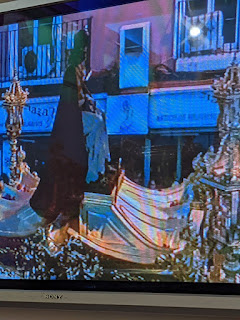Malaga is famous for being the birthplace of Pablo Picasso, though his family moved when he was 10 in search of work. His father had been a painter and encouraged Picasso’s work. I like his early pre-cubism work much better than what he was famous for and saw a wonderful large portrait he did that is in the National Art Museum in Washington DC. We started the day exploring the city before entering the Picasso Museum. Picasso had always wanted a museum in Malaga but was particular about what kind of building was suitable. It has a collection of about 250 lesser known pieces, about half of which are on display at any one time.
 |
| This is a statue to an influential father of the city. |
 |
| Malaga has a delightful car-free downtown. |
 |
| Selected enlargements of old newspaper pages were embedded in the street. |
 |
| Some of the old streets were decorated with stones. |
 |
| This is an old street sign that indicated where carriages were allowed to enter. |
 |
| The Cathedral of Malaga with the Bishops's residence in the yellow home on the right. The church is known as the one-armed church because it only has one bell tower. |
 |
| This ad for a Malagan beer brand features a picture of a German tourist enjoying one. |
 |
| There are so many beautiful doors here, I had to include one. |
 |
| Interesting sculpture in front of a recently painted building whose clean surface was marred by a rain storm laden with dust from the Sahara which doesn't wash off easily. |
 | |
| El Pimpi (not a pimp) is a favorite character here and supposedly an early tour guide. There is an El Pimpi Restaurant that Antonio Banderas is a partner in. |
 | |
| Banderas owns the penthouse of this building, but we didn't see him. |
Once we got into the Picasso Museum, we had nearly an hour to explore the collection, which was more that enough time for me. I have a tendency to see many of the examples of modern art as a great joke on people with money who want to be seen as sophisticated patrons of the arts.The three pieces below represent my favorites out of the 120 we saw.
 | |
| One of Picasso's wives |
Behind the museum was a large plaza with more ruins.
Our next stop was at the storage area of a Christian brotherhood that participates in an annual mulitday religious display. They have enormous heavy floats that are carried for hours through the streets of Malaga, supported by teams of 240 men. Antonio Banderas happens to be part of this group and tries to get back each year to do his part.
 |
| The photo does a poor job of showing the 6 long metal poles that each take 40 men to lift. |
 |
| This is picture from a tv showing the religious decoration atop the float. |
This was our day for a lunch with a local resident and we went to a local square which was near 2 of the three apartments our group visited.
 |
| A statue of Picasso in the park. |
 |
| The apartment with the banners is where Picasso was born and lived for his 1st 10 years. |
Our local guide led us to our hostess' apartment and introduced us to Pilar, who spoke even less English than we spoke of Spanish, so my phone with google translate came in handy. As we arrived, she was just about to leave to pick up ice and so our local guide took over that job. Her apartment is on the 7th floor and the elevator only held 4 of us plus her at a time. In theory, two trips should have gotten the 8 of us to her floor in two trips, but apparently Jim thought the elevator was pretty full without him and waited for Pilar to collect him. She got distracted and pretty much ignored my question "Donde is Jim??" so Jim looked up her name, not realizing there were 2 Pilars in the building and started exploring. In the meantime, our local guide came back with the ice, but hadn't seen Jim because of his gallivanting, so I headed down the stairs to find him and the guide came with me. Fortunately, he realized he was lost and went back to the bottom where we were able to rescue him. Other than that, we had a totally delightful afternoon, though Pilar cooked more than twice as many Spanish tortillas as we could possibly eat.



























